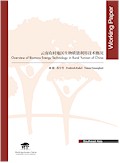| Working Paper Series |
 |
|
| Title | Overview of Biomass Energy Technology in Rural Yunnan of China in Chinese Language | | Author | Yan Mei, Su Yufang, Fredrich Kahrl and Timm Tennigkeit | | Year | 2009 | | Publisher | World Agroforestry Centre (ICRAF) China | | City of Publication | Kunming, China | | Series Number | ICRAF Working Paper No. 92 | | Number of Pages | 27 | | Call Number | WP0125-10 | | Keywords | China rural energy, biomass technology, biofuel |
|
| Abstract: |
| Driven by energy security concerns and increasingly severe pollution from coal-fired power generation, the Chinese government has begun to pay more attention to renewable energy as an alternative energy solution, proposing that renewable energy account for 10% of total energy consumption in 2010 and reach 20% by 2020. Bioenergy is an important part of these plans. Although biomass energy has struggled to achieve commercial scale, bioenergy is the primary energy source in much of rural China. With advanced energy conversion technologies, bioenergy can provide a renewable, clean, affordable, and stable source of energy for rural China in the future.
This working paper gives a brief introduction to biomass energy technologies in rural Yunnan Province, describing both their current status and prospects. Yunnan Province is typical of China, as most of its rural areas depend on inefficient combustion of firewood and crop residues to meet their energy needs. To address this situation, policymakers could set up a more effective mechanism to distribute limited funding resources; develop policies to promote and leverage a more vibrant rural energy market; and, in doing so, play a more active role in supplying rural communities with appropriate energy technologies. In our review of rural bioenergy technologies, we find that, although local governments have been subsidizing household biogas digesters and efficient stoves for more than two decades, little has changed in the structure of rural energy consumption; indeed, farmers recently have begun to use even more crop residues. Based on our analysis, insufficient inputs, inadequate technical services,
and a government-centered extension model are the main reasons that the status quo has been so persistent. Gasoline-ethanol and biodiesel are becoming the new darlings of bioenergy development in China, and Yunnan Province has tried to follow suit by heavily investing in scientific research and industrial development for liquid biofuels. This paper also discusses whether farmers could utilize this trend to meet a portion of their own energy demands, and analyzes a host of obstacles such as policy constraints, oil price fluctuations, feedstock production bottlenecks, and institutional difficulties. |
|